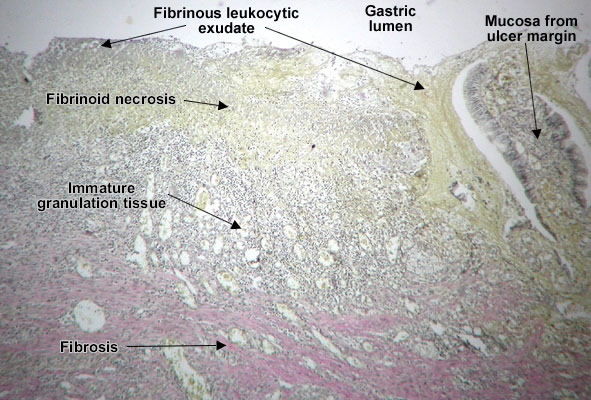DEFINITION
Fibrosis is the formation or development of excess fibrous connective tissue in an organ or tissue, as opposed to a formation of fibrous tissue as a normal constituent of an organ or tissue.

EPIDEMIOLOGY
age, sex, seasonality, etc
SYMPTOMS
DIAGNOSIS
histopathology
radiology
NMR
laboratory tests
PATHOGENESIS
Steps of connective tissue formation:
- Vessel wall permeability increase and proteins extravasation (Albumin and fibrinogen)
- Fibrin Clot formation (platelets and clotting factors)
- Fibroblasts proliferation on fibrin clot
- Collagen production by fibroblasts
- Excess collagen impairs nerves and vessels function (ischemia and pain)
- Collagen digestion and remodelling. Recovery
Redox mechanisms in hepatic chronic wound healing and fibrogenesis. 2008
Redox mechanisms in hepatic chronic wound healing and fibrogenesis 2008 PDF

Liver fibrosis and regeneration in dogs and cats : An immunohistochemical approach, 2008
PATIENT RISK FACTORS
Vascular
Genetic
Acquired
Hormonal
Genetic
Acquired
TISSUE SPECIFIC RISK FACTORS
anatomical (due its structure)
vascular (due to the local circulation)
physiopathological (due to tissue function and activity)
- Joints
- Skin
- Liver
- Hcv genotipo 1: fattori di rischio per la fibrosi
L'insulinoresistenza è uno dei principali fattori determinanti della fibrosi epatica avanzata nei pazienti con epatite C cronica derivante da Hcv di genotipo 1 (Hcv-G1), soprattutto in presenza di necroinfiammazione grave. Alcuni fattori metabolici possono influenzare il decorso dell'epatite C cronica; l'insulinoresistenza determina steatosi, ma il suo ruolo diretto nell'influenza della progressione della fibrosi epatica era finora meno chiaro. La possibilità che la correzione dell'insulinoresistenza tramite l'uso di farmaci insulinosensibilizzanti o modifiche dello stile di vita modifichi i suoi effetti sulla fibrosi epatica rimane da dimostrarsi in studi appropriati. (Am J Gastroenterol 2008; 103: 1136-44)
Hepatology. 2005 May;41(5):995-1003.
Hyperhomocysteinemia and the MTHFR C677T polymorphism promote steatosis and fibrosis in chronic hepatitis C patients.
Adinolfi LE, Ingrosso D, Cesaro G, Cimmino A, D'Antò M, Capasso R, Zappia V, Ruggiero G.
Division of Internal Medicine and Hepatology, Second University of Naples, Faculty of Medicine, Naples, Italy. luigielio.adinolfi@unina2.it
Comment in:
Hepatology. 2005 May;41(5):976-9.
Abstract
The factors and mechanisms implicated in the development of hepatitis C virus (HCV)-related steatosis are unknown. Hyperhomocysteinemia causes steatosis, and the methylenetetrahydrofolate reductase (MTHFR) C677T polymorphism induces hyperhomocysteinemia. We investigated the role of these factors in the development of HCV-related steatosis and in the progression of chronic hepatitis C (CHC). One hundred sixteen CHC patients were evaluated for HAI, fibrosis and steatosis grades, body mass index, HCV genotypes, HCV RNA levels, homocysteinemia, and the MTHFR C677T polymorphism. Hyperhomocysteinemia was associated with the TT genotype of MTHFR (r = 0.367; P = .001). Median values of homocysteine in the CC, CT, and TT genotypes of the MTHFR gene were 9.3, 12.2, and 18.6 micromol/L, respectively (P = .006). Steatosis correlated with the MTHFR polymorphism, homocysteinemia, HAI and fibrosis. Steatosis above 20% was significantly associated with fibrosis. Prevalence and high grade (>20%) of steatosis were 41% and 11% in CC, 61% and 49% in CT, and 79% and 64% in TT, respectively (P = .01). Relative risk of developing high levels of steatosis was 20 times higher for TT genotypes than CC genotypes. According to multivariate analysis, steatosis was independently associated with hyperhomocysteinemia (OR = 7.1), HAI (OR = 3.8), liver fibrosis (OR = 4.0), and HCV genotype 3 (OR = 4.6). On univariate analysis, fibrosis was associated with age, steatosis, MTHFR, homocysteinemia and HAI; however, on multivariate analysis, liver fibrosis was independently associated with age (P = .03), HAI (P = .0001), and steatosis (P = .007). In conclusion, a genetic background such as the MTHFR C677T polymorphism responsible for hyperhomocysteinemia plays a role in the development of higher degree of steatosis, which in turn accelerates the progression of liver fibrosis in CHC.
- Kidney
- Lung
- Fibrosi polmonare idiopatica: test rischio mortalità
La proteina surfactante sierica A (SP-A), generata nei polmoni e liberata nel circolo periferico in caso di danno polmonare, è uno dei più forti fattori predittivi indipendenti di mortalità precoce nel primo anno dopo la diagnosi di fibrosi polmonare idiopatica. Essa risulta più utile in questo senso rispetto ad altri marcatori quali età, test di funzionalità polmonare o altri indicatori clinici convenzionali di malattia. L'incremento della concentrazione di SP-A potrebbe identificare un sottogruppo di pazienti con patologia maggiormente attiva a rischio di una mortalità precoce che non viene prevista sulla base di altri indicatori clinici, e consentirebbe di indirizzare le decisioni sul trattamento del paziente ed il suo eventuale inserimento immediato in uno studio clinico: nei casi più gravi, potrebbe aiutare a fissare un trapianto polmonare nel momento ottimale per il paziente. (Chest 2009; 135: 1557-63)
- L'azienda InterMune ha annunciato che La Commissione Europea ha concesso l'autorizzazione all'immissione in commercio per pirfenidone, medicinale indicato nel trattamento della Fibrosi polmonare idiopatica (Fpi), da lieve a moderata, malattia dei polmoni progressiva e con esito fatale. L'approvazione consente la commercializzazione di pirfenidone in tutti i 27 Stati Membri dell'UE e segna una svolta significativa nel trattamento delle oltre 100.000 persone afflitte da Fpi in Europa. «Il farmaco è il primo medicinale per la Fpi - ha dichiarato Dan Welch, Chairman, Chief Executive Officer e Presidente di InterMune - L'approvazione di pirfenidone non è solo una pietra miliare nel trattamento della Fpi, sino a oggi sprovvisto di medicinali approvati. Per l'evoluzione di InterMune, essa apre al contempo un nuovo ed emozionante capitolo, che prelude all'imminente trasformazione dell'Azienda in struttura operativa internazionale. InterMune ha costituito un forte Management Team Europeo, che sta già lavorando attivamente per rendere pirfenidone disponibile ai pazienti europei il più presto possibile».
- Stomach

Current concepts of pathomechanism of IPF
Mice lacking cystathionine beta synthase have lung fibrosis and air space enlargement. 2009
 Papers pirfenidone fibrosis
Papers pirfenidone fibrosis